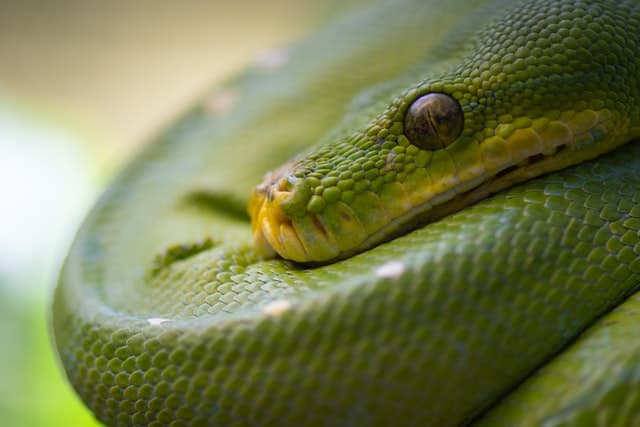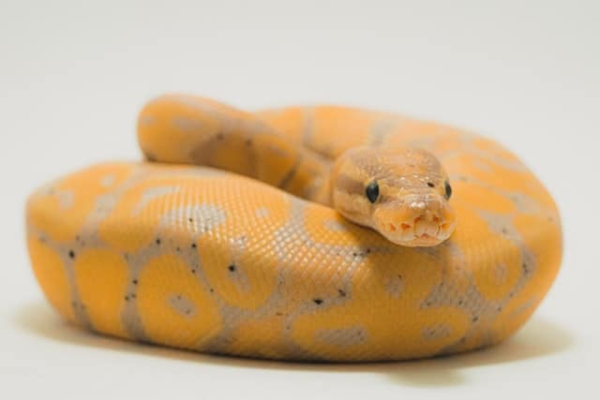
There’s no denying that snakes are the most fascinating and terrifying animals for quite a few people. As predators, they know no mercy for smaller animals and eagerly swallow them.
[toc]
Can what snakes eat be described as vegetarian dishes?
You have probably guessed that it is rather doubtful.
Find out what they like best.
What does a snake eat?

Like any snake – a predator requires feeding on prey in its entirety. To keep a snake, you must be prepared to feed it to other living creatures. There is no snake food, pellets with which you will satisfy its appetite, or specialized food for the grain snake, produced in a factory and aesthetically packaged.
It feeds on small warm-blooded animals. It is assumed that the size of its prey must be smaller than the width of the snake at its widest point, although older stranglers may have larger prey. A criterion is also adopted for the weight of the prey – it must not exceed 1/10 the weight of the snake. Otherwise, if the prey is too large, the snake may vomit it up, or it may injure the snake. If this happens, it should not be given food for about fourteen days, after which it should be given a small mouse donkey.
What does a gopher snake need? The food depends on its size. You can feed him mouse sucklings a day or a few days old. Over time, you can also feed rat sucklings, slightly older mice, gerbils, or even two- to four-week-old rats. Once the snake is an adult and has reached the right size, it can also eat older rats, those as young as five or six weeks old. If you have several snakes, they should be fed separately, preferably in different containers than the target terrarium.
Food for a grain snake is generally live – the snake will hunt the creature you give it on its own. However, if you really want to, you can teach a snake to eat dead food given with tweezers. This takes some practice and lots of patience, but it is doable.
How often to feed it?

You already know what, but do you know how often to feed your snake? Adult specimens do not need to be fed too often. Once every two to three weeks, in this case, is completely sufficient. On the other hand, juveniles should be fed about twice a week.
As you can guess, what snakes eat is mostly other living creatures. The specific tastes of these reptiles may vary, of course, but usually, predators do not deny themselves:
- birds;
- fish;
- amphibians;
- small mammals;
- other reptiles;
- eggs of various animals.
There is no shortage of snakes with other food preferences. Indeed, these animals can also eat insects, snails, or fish eggs.
Sometimes it happens that a snake does not want to eat. Then it is important to find out why. Snakes may refuse to eat just before moulting or, in the case of females, they are in advanced pregnancy. A snake may also not want to eat because the prey is too big or something is wrong with it. So always keep an eye on your snake to react appropriately in case of a possible illness that your drain snake may be suffering.
What it eats and how often you already know. However, you need to know something else – do not catch prey for him in the wild. Don’t hunt mice or rats – you may provide him with a sick or poisoned individual. A much better idea is to buy special food for animals from a reliable source.
How do snakes hunt their prey in the wild?

As you surely know, the animals in question are predators. It is known that they cannot bite or chew their food, so they are forced to swallow their prey whole. It is no secret that their lack of legs does not prevent them from hunting.
Snakes are excellent hunters, although they sometimes decide to devour carrion. However, when they do move on to attack, they use their venom or strangle their prey to kill it.
What do home-bred snakes eat?

Although a vegetarian or vegan diet is currently in vogue, you won’t convince a snake to eat it. Its instincts also make themselves known when it lives at home with humans. What snakes eat most willingly are living creatures. These are, above all:
- rats;
- mice;
- hamsters
- gerbils;
- guinea pigs;
- rabbits.
Type of food fed
Small mammals
The most commonly used type of food. Easy to grow and the best source of all the components necessary for a snake’s body to function properly. These include:
- mice;
- rats;
- gerbils;
- hamsters;
- guinea pigs;
- rabbits;
The first two species are the basis of snake feeding in terraria. Besides these, red voles and other species of voles from scientific institutes are also available. They are an excellent alternative for snakes that refuse to eat mice or as dietary enrichment.
Another rodent gaining popularity is the Mastomys – a prolific species also available at many terrarium exchanges. It is strongly discouraged to give rodents caught in their natural environment because they are most often the source of various diseases and parasites.
Chicks

One or a few days old chicks are the perfect food for medium-sized snakes. However, it is best that they are not the main component of their diet, and they should be purchased from a reliable source.
Fish
Snakes with this type of diet should be fed whole fish. Preferably any beauties (guppies, swordtails, mollies), young trout, and minnows (variation is important), although from time to time, one should try to convince a snake to eat a one-day-old mice suckling. Feeding diseased fish, pieces of fish (fillets), and long-distance feeding of marine fish are unacceptable. If food other than whole fish is refused, vitamin b-complex can be given every few feedings.
Insects and earthworms
Species with such specialized food preferences are recommended only to experienced keepers and are rarely found in home terrariums. Remember that it is best not to feed insects caught from the wild, as they can carry diseases or host parasites.
Earthworms are best collected immediately after a rain or can be purchased at most bait stores.
Reptiles and amphibians
A large number of snakes, without any hindrance, accept such food, and there are even cases where the individuals do not want to eat any other. Please note that native reptiles and amphibians are unconditionally protected, so it is forbidden to catch them from the wild for feeding purposes.
If you decide to breed a snake, remember that the first two suggestions on this list should form the basis for its balanced diet.
Should the snake drink a lot of water?
Snakes, like most pets, also need adequate hydration. Here are some tips and information.
- A full bowl of water should be in the terrarium at all times. You must adjust the size of the container to the specific species and the animal’s size.
- If your reptile likes to stay in the water, you should opt for a large pool.
- It is very important to constantly monitor the water level. Most snakes meet their physiological needs in it. The basis is, therefore, the systematic removal of debris.
- If you decide on an arboreal snake, you must water its terrarium daily. This reptile drinks water from the window panes, and you must give it this opportunity. Otherwise, the animal can acquire constipation and kidney disease.
Dead or live food
Live food

Feeding live animals are not the best method of nutrition because there is a high risk of injuring the snake by an aggressive rodent. Unfortunately, there are sometimes individuals that only accept this type of food. The entire feeding process with live food should be closely observed; if the snake is not interested in the food, immediately remove it.
Although in the vast majority of cases, the snake will cope with the given prey, there may be situations in which it clumsily grasps it and will begin to bite him. If there is such a possibility, it should be taken away from him (do not pull out if he wraps her body) or immobilize her mouth with tweezers. Most rats and hamsters can be very aggressive. Proper food sizing is also important – the smaller the prey, the greater the safety.
Dead food

This method is used by most experienced breeders. It completely eliminates the risk of injury and has many advantages:
- the feeder animal can be frozen so that:
- the frozen food is digested faster;
- after freezing, the majority of possible parasites are eliminated;
- easily create a food stockpile;
And also:
- we avoid unpleasant odours, which are associated with keeping live specimens;
- it is easy to hide medicines and vitamins in dead food;
- several methods can be used to feed newborns (which cannot be achieved with live ones);
As you can see, feeding on dead food is the best solution – if only the snake is willing to accept this type of food. With some patience and the right approach, even the most reluctant specimens will be convinced of this type of food.


